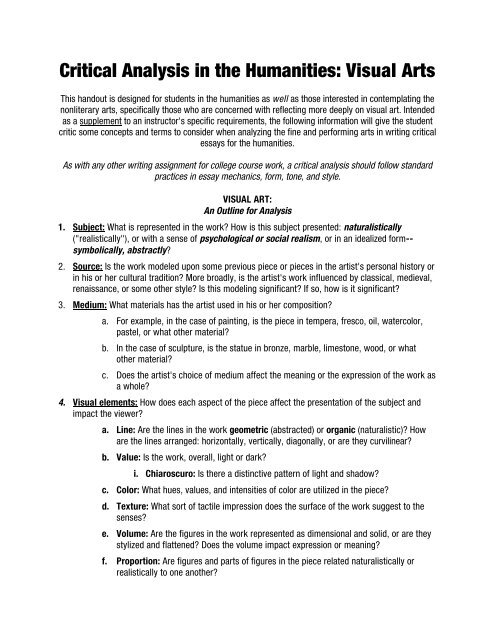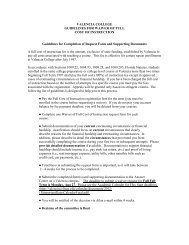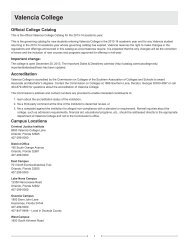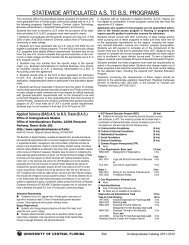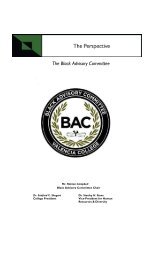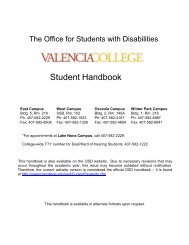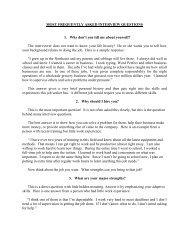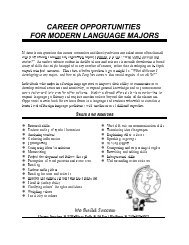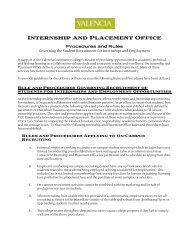Critical Analysis Visual Art CSSC TipSheet ... - Valencia College
Critical Analysis Visual Art CSSC TipSheet ... - Valencia College
Critical Analysis Visual Art CSSC TipSheet ... - Valencia College
You also want an ePaper? Increase the reach of your titles
YUMPU automatically turns print PDFs into web optimized ePapers that Google loves.
<strong>Critical</strong> <strong>Analysis</strong> in the Humanities: <strong>Visual</strong> <strong>Art</strong>s<br />
This handout is designed for students in the humanities as well as those interested in contemplating the<br />
nonliterary arts, specifically those who are concerned with reflecting more deeply on visual art. Intended<br />
as a supplement to an instructor's specific requirements, the following information will give the student<br />
critic some concepts and terms to consider when analyzing the fine and performing arts in writing critical<br />
essays for the humanities.<br />
As with any other writing assignment for college course work, a critical analysis should follow standard<br />
practices in essay mechanics, form, tone, and style.<br />
VISUAL ART:<br />
An Outline for <strong>Analysis</strong><br />
1. Subject: What is represented in the work? How is this subject presented: naturalistically<br />
("realistically"), or with a sense of psychological or social realism, or in an idealized form-symbolically,<br />
abstractly?<br />
2. Source: Is the work modeled upon some previous piece or pieces in the artist's personal history or<br />
in his or her cultural tradition? More broadly, is the artist's work influenced by classical, medieval,<br />
renaissance, or some other style? Is this modeling significant? If so, how is it significant?<br />
3. Medium: What materials has the artist used in his or her composition?<br />
a. For example, in the case of painting, is the piece in tempera, fresco, oil, watercolor,<br />
pastel, or what other material?<br />
b. In the case of sculpture, is the statue in bronze, marble, limestone, wood, or what<br />
other material?<br />
c. Does the artist's choice of medium affect the meaning or the expression of the work as<br />
a whole?<br />
4. <strong>Visual</strong> elements: How does each aspect of the piece affect the presentation of the subject and<br />
impact the viewer?<br />
a. Line: Are the lines in the work geometric (abstracted) or organic (naturalistic)? How<br />
are the lines arranged: horizontally, vertically, diagonally, or are they curvilinear?<br />
b. Value: Is the work, overall, light or dark?<br />
i. Chiaroscuro: Is there a distinctive pattern of light and shadow?<br />
c. Color: What hues, values, and intensities of color are utilized in the piece?<br />
d. Texture: What sort of tactile impression does the surface of the work suggest to the<br />
senses?<br />
e. Volume: Are the figures in the work represented as dimensional and solid, or are they<br />
stylized and flattened? Does the volume impact expression or meaning?<br />
f. Proportion: Are figures and parts of figures in the piece related naturalistically or<br />
realistically to one another?
i. For example, is the head in realistic proportion to the body, are human figures<br />
realistically sized to one another?<br />
ii. Are buildings and human figures presented in natural proportions? If they are<br />
not realistically delineated, how are they presented? Are they abnormally<br />
related?--is there foreshortening, elongation?<br />
iii. What do the proportions indicate? Do the proportions suggest meanings, or are<br />
they merely stylistic--specific to the artist's style or to the style of a particular<br />
cultural movement?<br />
g. Space: Is the space of the work flattened into a particular place, or is it extended into<br />
depth by means of linear or aerial perspective? Is the space open or closed? Does this<br />
depiction of space have significance or suggest meaning? How? Why?<br />
5. Organization: Is the design symmetrical (balanced) or asymmetrical (unbalanced)? Is the design<br />
organized in a radial, pyramidal, vertical, or horizontal fashion? Does the design of the piece seem<br />
formally arranged, naturally arranged, or both? Does the work seem disorganized, perhaps<br />
intentionally? Does it accept or reject traditional or commonsensical ideas of order?<br />
a. How do all these elements of organization--the answers you gave to the items above-contribute<br />
to the artist's expression and to the meaning of the work itself as a whole?<br />
6. Theme: In your judgment, based on the overall analysis detailed above, what is the artist<br />
attempting to express or suggest? Is the attempt successful? If so, why is it a success; if not, why<br />
is it not a success?<br />
TERMS<br />
− chiaroscuro: of or relating to the technique of representing light and shadow in pictorial<br />
representation<br />
− curvilinear: descriptive of lines that are curved, rounded in contrast to straight<br />
− fresco: of or relating to the art of painting with colors mixed in water and applied to fresh plaster<br />
− pastel: of or relating to pictures or sketches drawn with a crayon made of a paste of ground and<br />
mixed pigment<br />
− tempera: of or relating to painting done with pigment mixed with egg yolk or a similar watersoluble<br />
material


